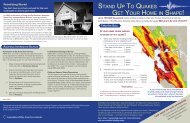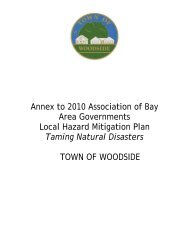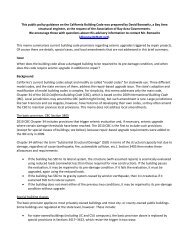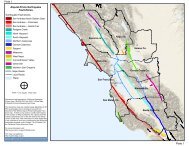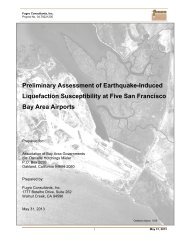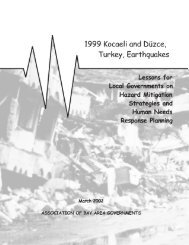<strong>Safe</strong> <strong>Enough</strong> <strong>to</strong> <strong>Stay</strong>Section III RecommendationsA post-earthquake alternative habitability st<strong>and</strong>ard should beestablished <strong>and</strong> implemented in order <strong>to</strong> encourage residents <strong>to</strong>shelter in place. The following recommendations will help <strong>to</strong> achievethis goal.8. Create an interdepartmental shelter-in-place taskforce.The Mayor’s Office should create an interdepartmental shelterin-placetask force. This task force will ensure coordination withthe Department of Building Inspection, the San Francisco FireDepartment (which has joint jurisdiction on multifamily housing <strong>and</strong>must agree <strong>and</strong> cooperate with regard <strong>to</strong> shelter-in-place st<strong>and</strong>ards),the Department of Public Health <strong>and</strong> the Department of EmergencyManagement. Other agencies that should be involved include theDepartment of Public Works, the Mayor’s Office on Disability <strong>and</strong> theMayor’s Office of Housing, among others.9. Prepare <strong>and</strong> adopt regulations that allow for theuse of shelter-in-place habitability st<strong>and</strong>ards in adeclared housing-emergency period.Shelter-in-place st<strong>and</strong>ards may be adopted in advance of anemergency or be completed <strong>and</strong> ready <strong>to</strong> adopt as part of the city’semergency measures. Various agencies should adopt administrativebulletins <strong>and</strong> similar regulations that detail how code requirements<strong>and</strong> policies will need <strong>to</strong> be implemented. These should includecomplaint, inspection <strong>and</strong> enforcement procedures.During a declared emergency, a separate housing emergencymay also be declared, which would allow the enforcement of thealternative shelter-in-place habitability st<strong>and</strong>ards. A declared housingemergency may continue as a special emergency period past thegeneral declared emergency period <strong>and</strong> may be applied <strong>to</strong> specificareas where housing is most severely impacted.10. Develop a plan <strong>to</strong> implement a shelter-in-placeprogram.This implementation plan should include creating public trainingmaterials, coordinating with existing post-disaster building-evaluationprocedures <strong>and</strong> s<strong>to</strong>ckpiling the materials needed <strong>to</strong> achieve shelter inplace in the post-disaster period.A. Preparing public training materialsThe interagency task force recommended above should developsimple <strong>and</strong> clear training materials for residents <strong>to</strong> help them37 For a full list of services needed in neighborhood support centers, seeAppendix III, page 42.determine whether or not they can shelter in place. These shouldinclude a set of graphic illustrations <strong>and</strong> a shelter-in-place checklist,which should be incorporated in outreach <strong>and</strong> training materials <strong>to</strong>building owners <strong>and</strong> residents <strong>to</strong> inform them of shelter-in-placehabitability requirements, st<strong>and</strong>ards, inspection procedures <strong>and</strong> repairexpectations. The training materials could also include such elementsas door tags that say, “I’m Okay!” or “I Need Help.” Additionally,residents could receive special training in shelter in place prior <strong>to</strong> anevent, much like the current Neighborhood Emergency ResponseTeam (NERT) program.B. Coordinating with existing post-disaster evaluation proceduresAfter an earthquake, professionals will come from all over the country<strong>to</strong> help evaluate buildings using the ATC-20 evaluation procedure.If San Francisco’s evaluation procedures are modified <strong>to</strong> focus onshelter in place, ATC-20 inspec<strong>to</strong>rs will need <strong>to</strong> be trained in SanFrancisco–based shelter-in-place habitability st<strong>and</strong>ards. This trainingcan be done when ATC-20 inspec<strong>to</strong>rs check in with the Departmen<strong>to</strong>f Building Inspection before being released in<strong>to</strong> the field <strong>to</strong> conductinspections.C. S<strong>to</strong>ring materials necessary <strong>to</strong> allow shelter-in-place st<strong>and</strong>ards<strong>to</strong> be metThe city will need <strong>to</strong> have certain materials, such as plastic sheetingfor weather protection, on h<strong>and</strong> for use after a major earthquake.SPUR recommends that the Department of Building Inspection,the Department of Emergency Management <strong>and</strong> the Department ofPublic Health coordinate <strong>to</strong> develop a list of these materials <strong>and</strong> thequantities that will be needed.11. Develop plans for neighborhood support centers<strong>to</strong> provide necessary help for shelter-in-placecommunities.Neighborhood support centers are not emergency shelters. Rather,they are resource centers that encourage people <strong>to</strong> stay in theirhomes by providing essential services <strong>and</strong> information. A s<strong>to</strong>re,restaurant, small business, religious or social facility could provide thenecessary space, but a large garage or other covered area could alsosuffice. These neighborhood support centers will need <strong>to</strong> be staffed<strong>and</strong> equipped <strong>to</strong> offer the following services, or quick contact withsuch services 37 :• Information, news <strong>and</strong> general neighborhood communication <strong>and</strong>contact• Telephone, digital, postal <strong>and</strong> other communication services• Volunteer assistance in conducting shelter-in-place evaluations(on-site or immediately available when required)• Referrals <strong>to</strong> community service organizations <strong>and</strong> agencies• Distribution of supplies, water <strong>and</strong> food• Refrigeration for critical supplies (medication, etc.)• Connection <strong>to</strong> services such as laundry facilities• Electrical supply, including electronics-charging facilities• Emergency, basic <strong>and</strong> major medical care30 SPUR Report > January 2012
Section IV:Applicability <strong>to</strong> otherjurisdictionsSan Francisco is not the only jurisdiction in the Bay Area that isat risk of a seismic event. The United States Geological Surveyestimates that there is a 63 percent chance of a major earthquakeoccurring in the Bay Area some time in the next 30 years. TheHayward Fault is the most likely <strong>to</strong> rupture, causing massive damagein the East Bay.Much of the work developed for this report <strong>and</strong> prior SPUR reportsis applicable <strong>to</strong> other seismically vulnerable jurisdictions. Otherjurisdictions could implement the following set of recommendations <strong>to</strong>increase seismic resilience.1. Define resilience <strong>and</strong> develop a specific target forhousing performance.In our 2009 report “Defining What San Francisco Needs from ItsSeismic Mitigation Policies,” SPUR developed performance targetsfor buildings <strong>and</strong> lifelines, including a goal of 95 percent shelter inplace for housing. This approach of setting a defined <strong>and</strong> ambitiousgoal for community recovery has resonated with policymakers<strong>and</strong> the technical community. Other jurisdictions could take theseperformance targets <strong>and</strong> adapt them <strong>to</strong> meet their own needs.2. Complete inven<strong>to</strong>ries of vulnerable housing s<strong>to</strong>ck.Creating inven<strong>to</strong>ries will be a critical first step. SPUR’s analysis <strong>and</strong>recommendations for San Francisco build on reliable data <strong>and</strong> lossestimates produced by SPUR committees, the local engineeringcommunity <strong>and</strong> the CAPSS project. Other jurisdictions might need<strong>to</strong> undertake similar building counts <strong>and</strong> mapping exercises <strong>to</strong> relatestructure types <strong>and</strong> geologic hazards <strong>to</strong> residential occupancies <strong>and</strong>demographics.4. Make use of the shelter-in-place evaluation criteriaproposed in Section II of this report.SPUR has called for the further development of these criteria, whichcan be applied in other jurisdictions seeking <strong>to</strong> evaluate their housings<strong>to</strong>ck for shelter-in-place performance. In particular, the proposedcriteria apply jurisdiction-specific maps <strong>and</strong> default values. Otherjurisdictions can begin developing similar data now, even as SanFrancisco works on completing the generic criteria. In addition, SanFrancisco has worked with FEMA <strong>to</strong> produce a new engineeringmethodology specifically for the cost-effective evaluation <strong>and</strong> retrofi<strong>to</strong>f wood-frame soft-s<strong>to</strong>ry apartment buildings.5. Build on the work being done by SanFrancisco’s Lifelines Council <strong>to</strong> analyze utilityinterdependency.San Francisco has convened a council of all utility providers withinfrastructure serving San Francisco. As part of its work, the LifelinesCouncil is conducting a study of the interdependency betweenutilities such as electricity, water, sewer, communications <strong>and</strong>transportation <strong>to</strong> uncover potential weaknesses in these systemsthat could cause cascading impacts after an earthquake if they arenot adequately planned for. Once complete, this study will includefindings that will be of use <strong>to</strong> other parts of the region, since manyutilities are regional in scope.6. Make use of the post-earthquake alternativeshelter-in-place habitability st<strong>and</strong>ards proposed inthis report.Each jurisdiction will need <strong>to</strong> develop alternative shelter-in-placehabitability st<strong>and</strong>ards in order <strong>to</strong> encourage sheltering in place.The timeline in Figure 6 (page 28) can serve as the basis for thesest<strong>and</strong>ards. Materials developed in San Francisco (for example, theshelter-in-place graphic illustrations <strong>and</strong> checklist) can help otherjurisdictions create comparable materials.3. Develop procedures <strong>to</strong> retrofit vulnerable housingtypes.Building on the work done in CAPSS, San Francisco is developing adetailed program <strong>to</strong> both evaluate <strong>and</strong> retrofit soft-s<strong>to</strong>ry wood-framemultifamily housing with five or more units <strong>and</strong> three or more s<strong>to</strong>ries.Other jurisdictions may have comparable types of vulnerable housing.As San Francisco develops evaluation <strong>and</strong> retrofit st<strong>and</strong>ards, otherjurisdictions can adapt these <strong>to</strong> meet their needs.SPUR Report > January 2012 31



